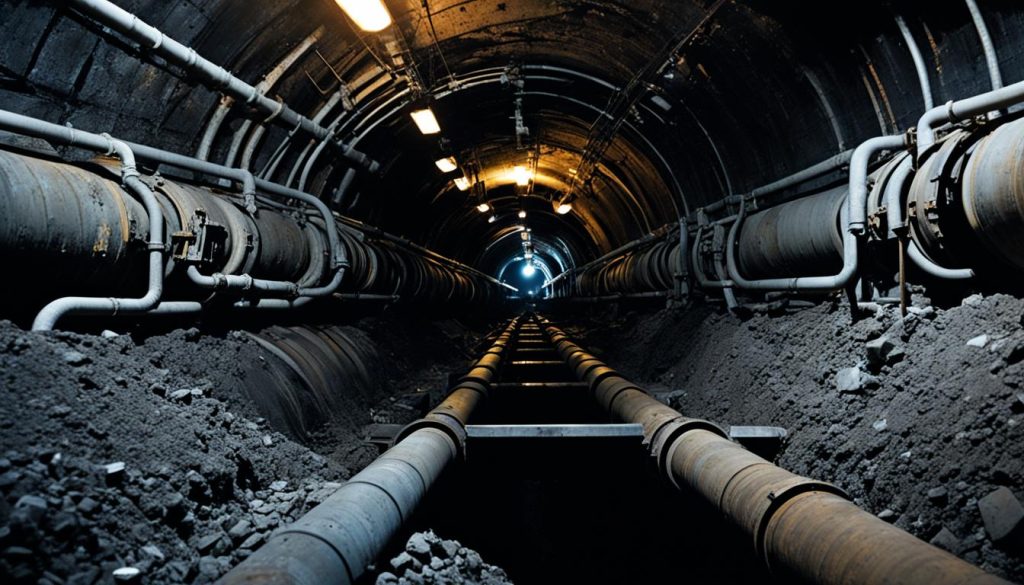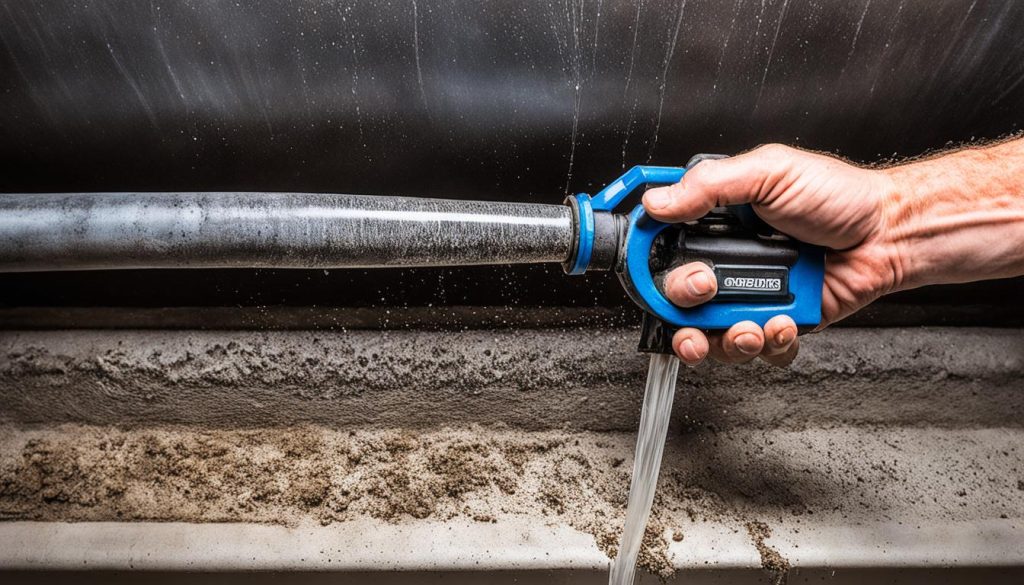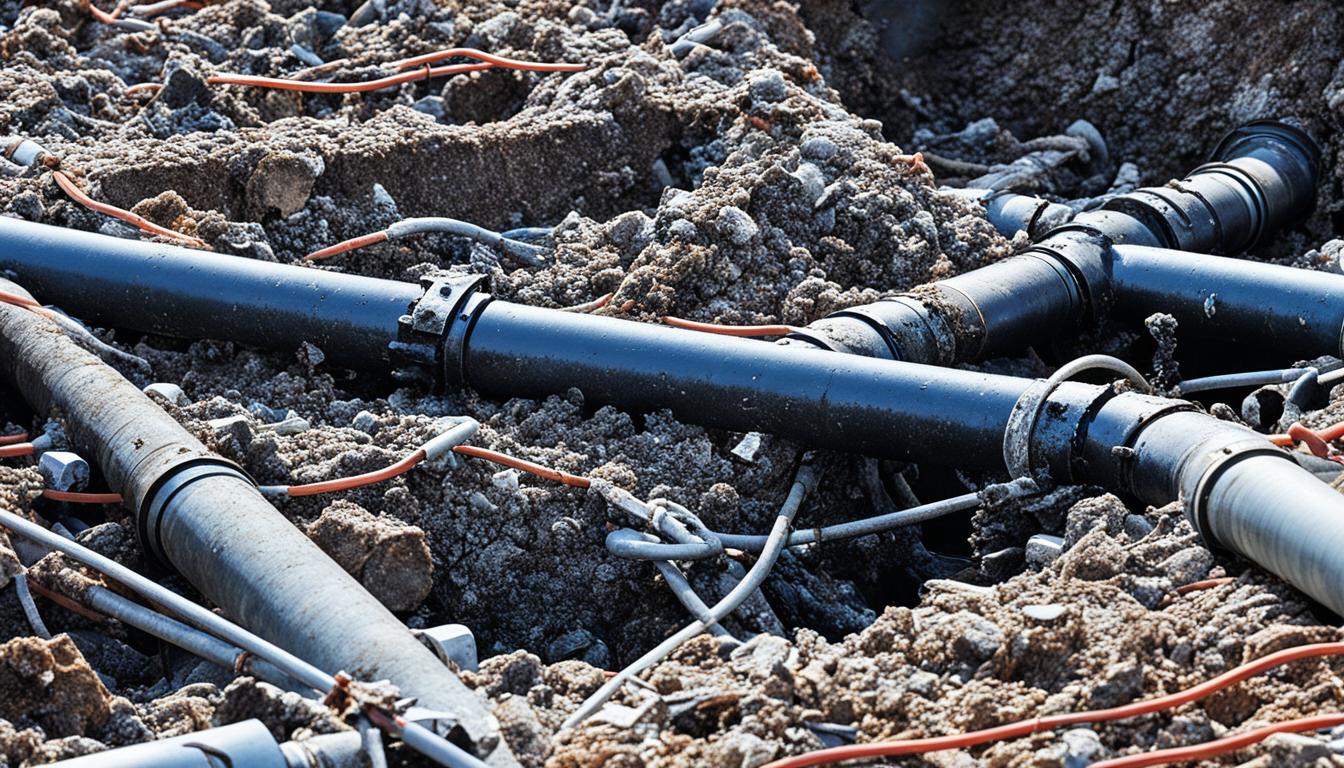Did you know that clogged drains and sewer lines are one of the most common plumbing problems experienced by homeowners? In fact, according to recent studies, nearly 80% of plumbing service calls are related to drain and sewer line issues. This startling statistic highlights the importance of clean out plumbing and regular maintenance to ensure clear and clog-free pipes.
Key Takeaways:
- Regular clean out plumbing maintenance is essential for preventing drainage problems, leaks, and unpleasant odors.
- Understanding sewer line cleanouts and the difference between the sewer system and drain system is crucial for effective maintenance.
- Locating your main sewer line and cleanout can aid in troubleshooting and easy access for professional plumbers.
- Recognizing the signs of a clogged sewer line or drain system allows for prompt action and prevention of further damage.
- DIY methods such as baking soda and vinegar or enzyme-based cleaners can be effective for minor clogs, but severe clogs or complex issues may require professional plumbing services.
Understanding Sewer Line Cleanouts
A sewer cleanout is an important component of the plumbing system that allows plumbers to access and maintain the sewer lines. It is typically installed at main elbows, the end of the system, and the connection to the municipality’s sewer system. The cleanout is equipped with threaded caps that can be easily removed to insert tools such as snakes or jets for cleaning purposes.
The sewer system refers to the part of the plumbing system that extends outside of the home. It comprises a network of pipes that carry waste and wastewater away from the property and towards the municipal sewer system. On the other hand, the drain system is located inside the home and includes pipes that connect to various plumbing fixtures like sinks, toilets, and showers.
Within the sewer lines, traps are strategically placed to prevent sewer gases from entering the home. These traps work by forming a water seal that acts as a barrier and prevents the gases from flowing back into the house. Additionally, vents are installed to allow the free flow of air and prevent vacuum build-up within the drainage system.
Proper maintenance of sewer line cleanouts and the sewer system is crucial to ensure the smooth operation of the plumbing system and prevent issues such as blockages, backups, and unpleasant odors. Regular inspection and cleaning of sewer lines can help identify potential problems early on and avoid costly repairs in the future.
| Sewer Line Cleanout Components | Function |
|---|---|
| Threaded caps | Allows easy access to insert tools for cleaning |
| Traps | Prevents sewer gases from entering the home |
| Vents | Prevents vacuum build-up in the drainage system |
Locating Your Main Sewer Line
The main sewer line is a crucial component of your plumbing system. It serves as the main conduit where all the drain pipes from your home converge. By understanding the location and structure of your main sewer line, you can effectively troubleshoot and maintain your plumbing system.
In most homes, the main sewer line is typically found in the basement, running along the perimeter towards the city’s sewer system. It is important to note that the main sewer line is usually larger in size compared to other pipes in your plumbing system.
When it comes to material, modern main sewer lines are commonly made of white plastic PVC pipes. However, in older homes, the main sewer line might be a black cast iron pipe. Knowing the material of your main sewer line can provide valuable insight into its durability and potential issues.

Locating the Cleanout
At the ends of the main sewer line, you’ll find a cleanout. The cleanout is a critical access point that allows plumbers to easily snake or clean the system without having to work through fixtures like sinks or toilets. It is essential to know the location of your cleanout as it provides convenient access for maintenance and troubleshooting purposes.
Consulting a Plumbing Professional
Locating your main sewer line and cleanout can be challenging, especially if you’re unfamiliar with your plumbing system. If you’re unsure about the exact location or if you’re dealing with a complex plumbing issue, it is highly recommended to consult a professional plumber.
A licensed plumbing professional possesses the knowledge and expertise to accurately locate your main sewer line and cleanout. They can also provide valuable advice on maintenance and repair options specific to your plumbing system. Investing in the services of a plumbing professional can save you time, effort, and potential damage to your plumbing system.
Summary
Locating your main sewer line and cleanout is essential for effective plumbing system maintenance and troubleshooting. The main sewer line serves as the central pathway for all drain pipes in your home, while the cleanout provides easy access for professional cleanings. If you’re unsure about the location or need assistance, don’t hesitate to reach out to a plumbing professional for guidance.
Signs of a Clogged Sewer Line or Drain System
A clogged sewer line or drain system can cause various problems that can disrupt the normal functioning of your plumbing system. It’s important to be aware of the signs that indicate a potential clog so that you can address them promptly. Here are some common signs to watch out for:
- Slow drainage: If you notice that water is taking longer than usual to drain from sinks, showers, or toilets, it could be a sign of a clogged sewer line or drain system. The buildup of waste and debris restricts the flow of water, causing slow drainage.
- Drain smells: Foul odors coming from your drains are another indication of a clog. As waste accumulates in the pipes, it can produce unpleasant smells that permeate through your plumbing system and into your home.
- Gurgling sounds: If you hear gurgling sounds coming from your drains or toilets when water is being used elsewhere in your home, it could be a sign of a clogged sewer line. The gurgling noise is caused by air bubbles trapped in the pipes attempting to escape.
- Frequent clogs: Do you find yourself dealing with clogs in your sinks, showers, or toilets on a regular basis? This could be a result of a clogged sewer line or drain system. When there’s a blockage in the main sewer line, it can impact multiple fixtures in your home.
These signs often indicate a buildup of waste, debris, or other substances in your pipes that require attention. Ignoring these signs can lead to further damage and potential plumbing emergencies.
If you’re experiencing any of these signs, it’s recommended to seek professional help for sewer line cleaning. A plumbing professional will have the tools and expertise to properly diagnose and address the clog, restoring proper flow to your plumbing system.
DIY Methods for Cleaning Out Sewer Lines
When it comes to cleaning out sewer lines, there are several DIY methods that homeowners can try. These methods can effectively tackle minor clogs and help maintain the proper flow of wastewater in your plumbing system. However, it’s important to note that for more severe clogs or complex issues, it’s best to call a professional plumber. Here are some popular DIY methods for cleaning out sewer lines:
Baking Soda and Vinegar
One popular and eco-friendly method is using a mixture of baking soda and vinegar. This natural combination helps break down grease and organic matter that may be causing the clog. Follow these steps to use baking soda and vinegar for sewer line cleaning:
- Pour 1 cup of baking soda down the drain.
- Follow it with 1 cup of vinegar.
- Let the mixture sit for at least 30 minutes.
- Flush with hot water to clear the debris.
Enzyme-Based Cleaner
An enzyme-based cleaner is another effective option for clearing clogged sewer lines. These cleaners contain natural enzymes that break down waste and grease, helping to restore proper flow. Follow the instructions on the product packaging for best results.
Snaking the Drain
If the clog is located closer to the cleanout, you can try snaking the drain using a smaller, handheld snake. This tool helps to push and break up the clogs, allowing the wastewater to flow freely again. Remember to exercise caution and follow the proper technique when using a drain snake.
While DIY methods can be effective for minor clogs, they may not always solve the problem completely. If you’re experiencing persistent clogs or if the clog is located deep within the sewer line, it’s best to seek the assistance of a professional plumber who has the tools and expertise to perform thorough sewer line cleaning.

To give you a better idea of the effectiveness of different DIY methods for cleaning out sewer lines, here’s a comparison of their pros and cons:
| Method | Pros | Cons |
|---|---|---|
| Baking Soda and Vinegar | – Natural and eco-friendly – Can break down grease and organic matter – Easy to find and use |
– May not be effective for severe clogs – Requires time for the mixture to work |
| Enzyme-Based Cleaner | – Breaks down waste and grease – Convenient to use |
– May not work for all types of clogs – Requires proper application and sufficient contact time |
| Snaking the Drain | – Can reach clogs closer to the cleanout – Removes physical obstructions |
– Limited reach for deep clogs – Requires proper technique and care to avoid damaging pipes |
By understanding these different DIY methods and their pros and cons, you can determine the most suitable approach for cleaning out your sewer lines. Remember, it’s always recommended to prioritize safety and consult a professional plumber when needed.
Tips for Preventing Clogged Drain Lines
Regular drain line maintenance is crucial for keeping your plumbing system clear and clog-free. By following a few simple preventative measures, you can avoid the hassle and expense of dealing with clogged drain lines. Here are some handy tips to help you maintain clear and efficient drains in your home.
Firstly, it’s important to dispose of grease properly. Never rinse grease down the drain, as it can solidify and cause blockages. Instead, allow it to cool and then dispose of it in the trash.
Another effective and easy way to prevent clogs is by pouring boiling water down your sinks and shower drains once a week. The hot water helps to break down any accumulated grease and flush it away, ensuring smooth drainage.
For regular cleanings, create a mixture of dish soap and boiling water. This solution effectively dissolves any greasy residue in the drain pipes and helps to keep them clean. Use this method monthly to maintain optimal drain performance in your home.
To deep clean your drains, you can also use a natural mixture of salt and vinegar. This powerful combination helps to eliminate stubborn clogs and remove any built-up debris in the pipes. Pour the mixture down the drain, let it sit for an hour, and then flush it with hot water to clear away the remnants.
By incorporating these simple tips into your regular maintenance routine, you can ensure clear drain lines and minimize the risk of clogs. Remember, prevention is key when it comes to maintaining a healthy plumbing system.
Source Links
- https://www.forbes.com/home-improvement/plumbing/sewer-line-cleanout-guide/
- https://www.thisoldhouse.com/plumbing/21164644/how-to-clear-any-clogged-drain
- https://www.forbes.com/home-improvement/plumbing/how-to-clear-clogged-drain/
